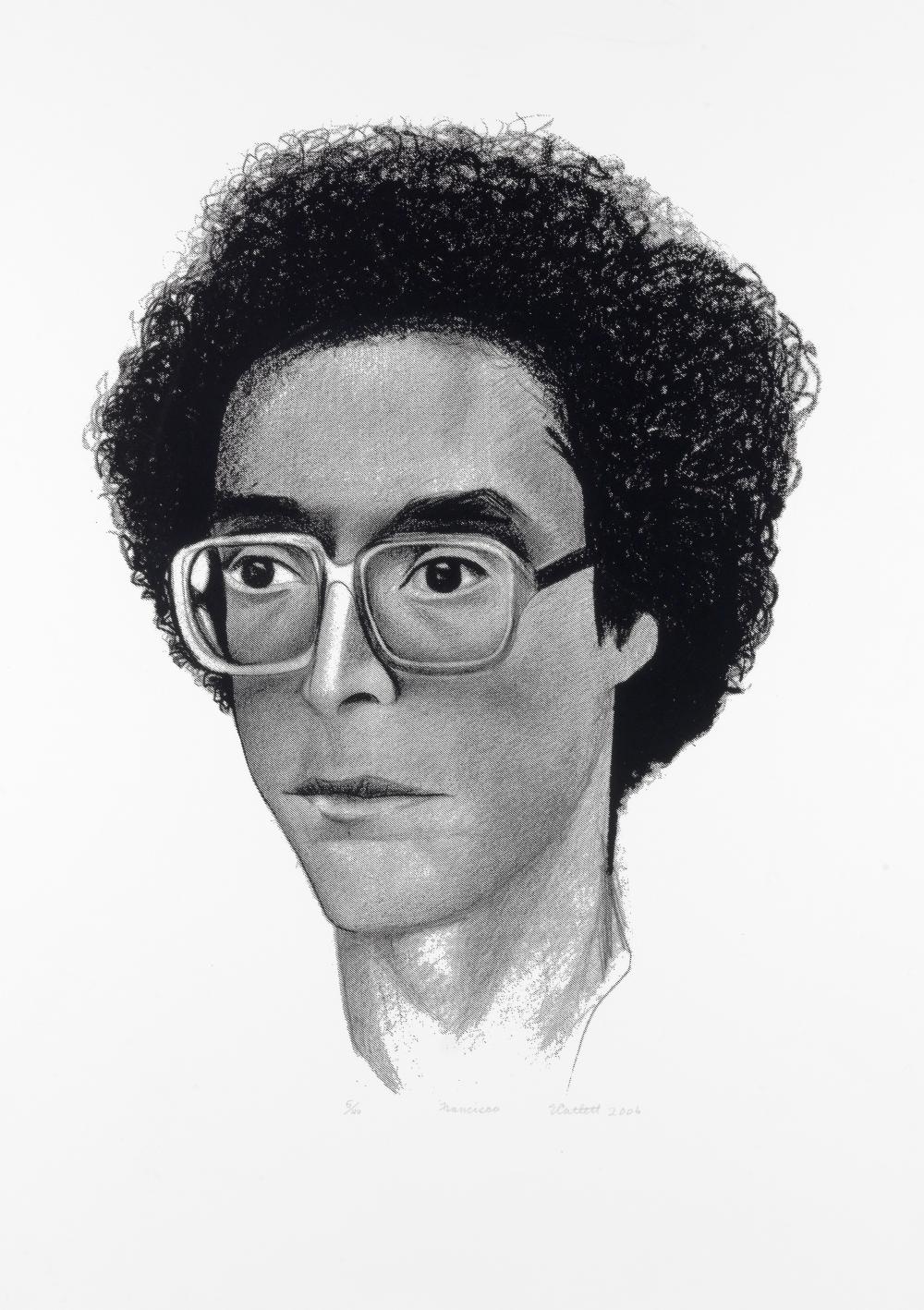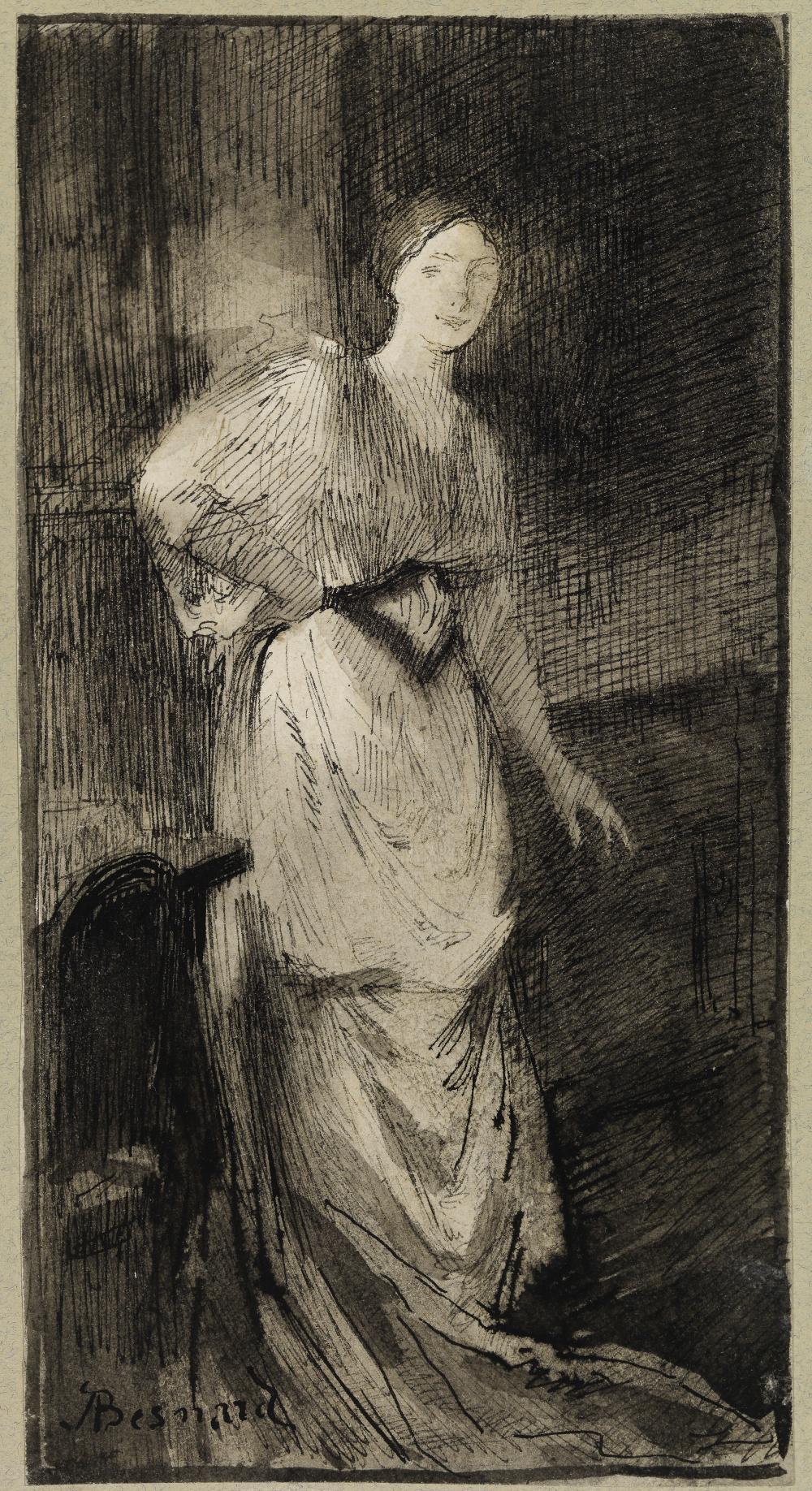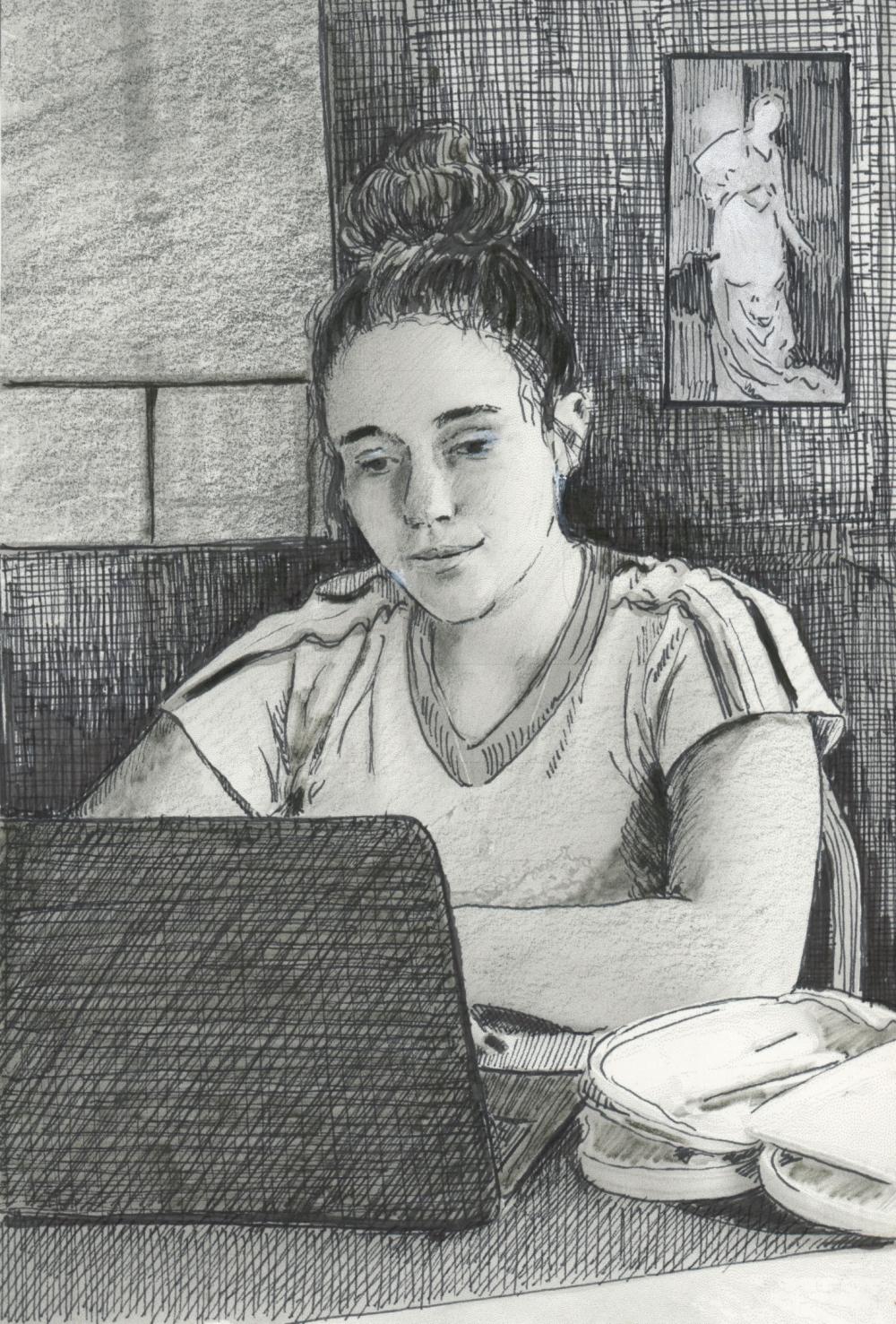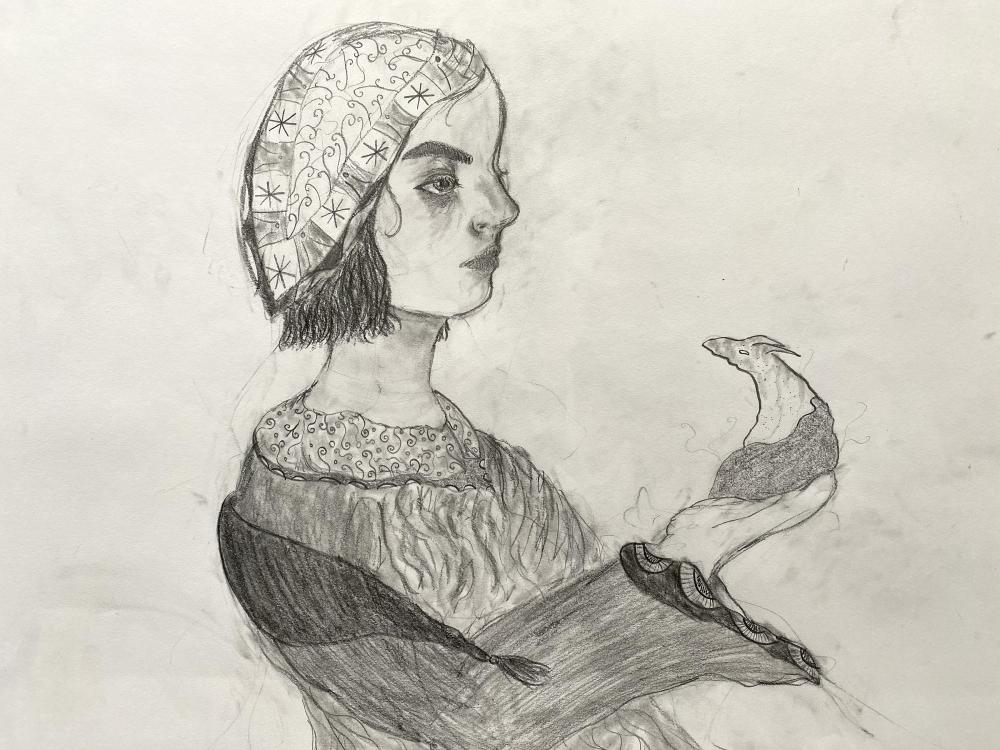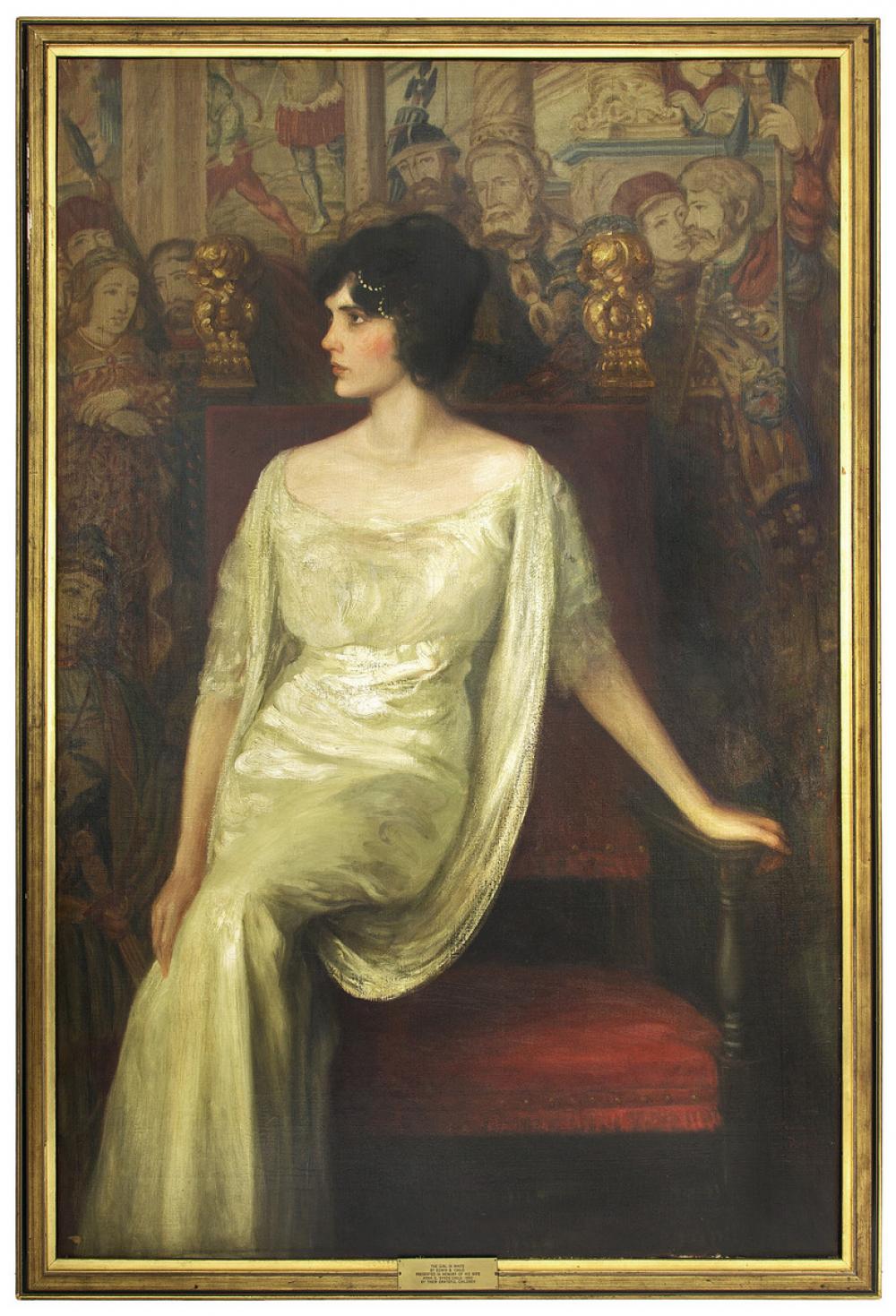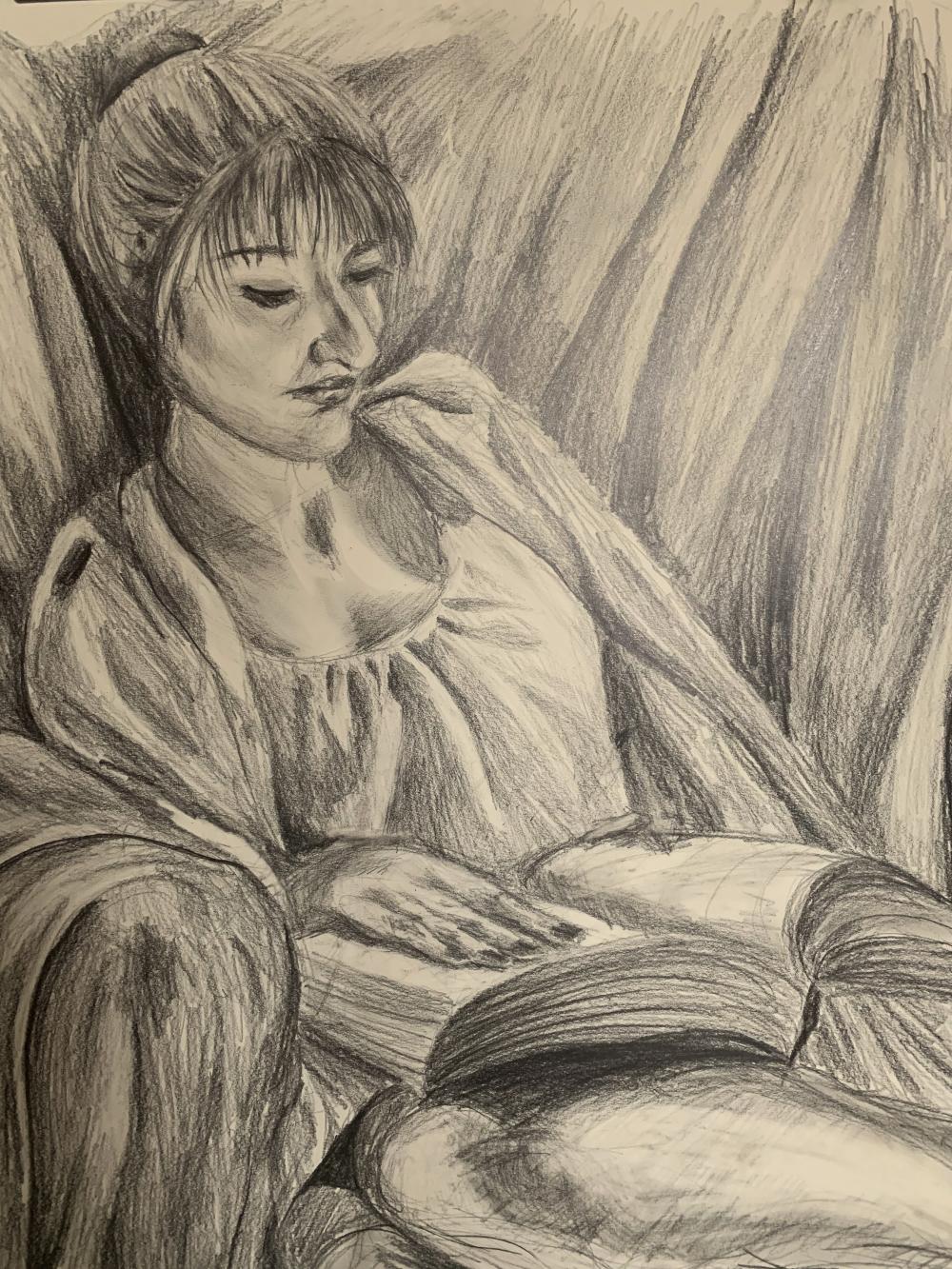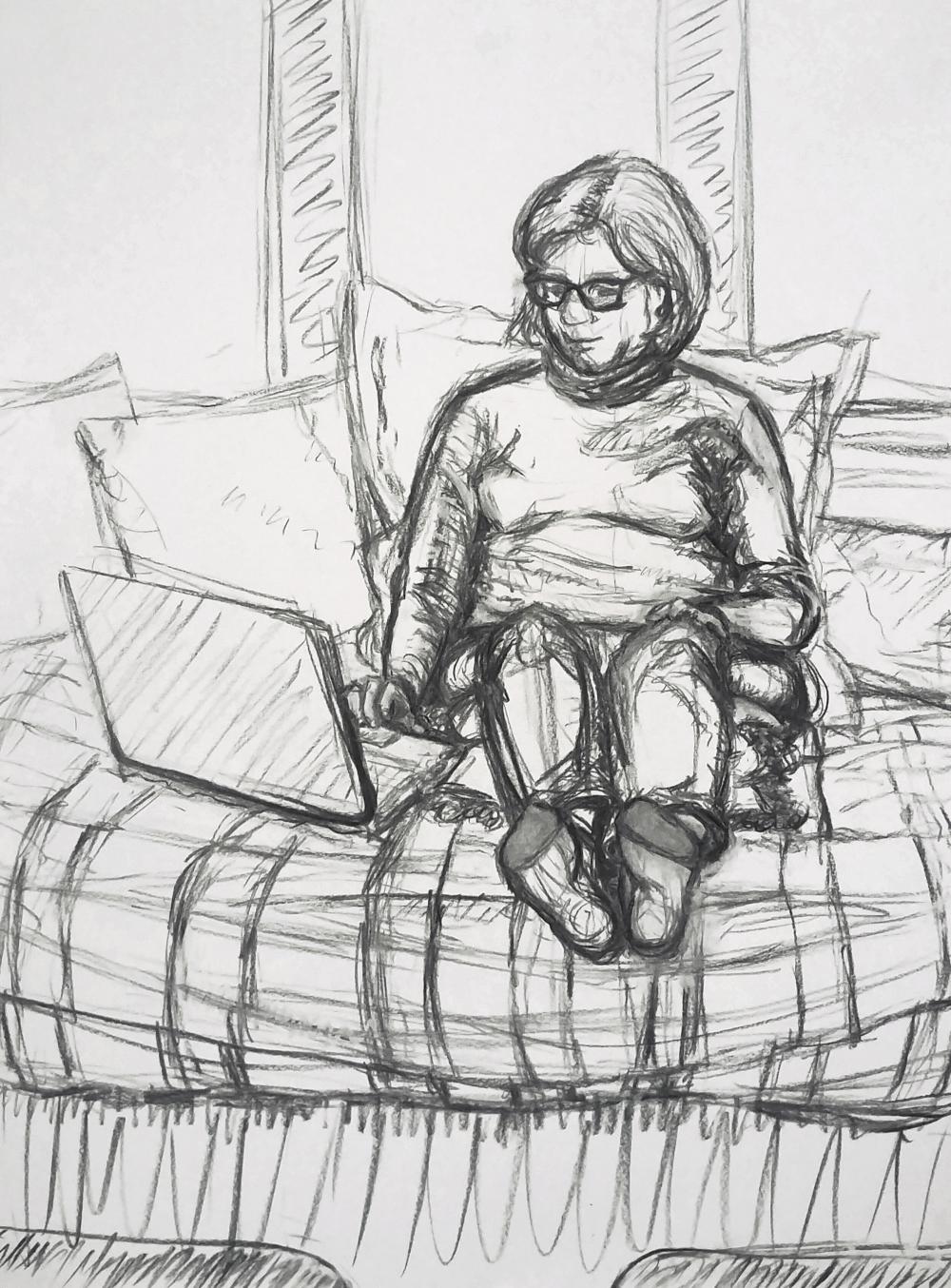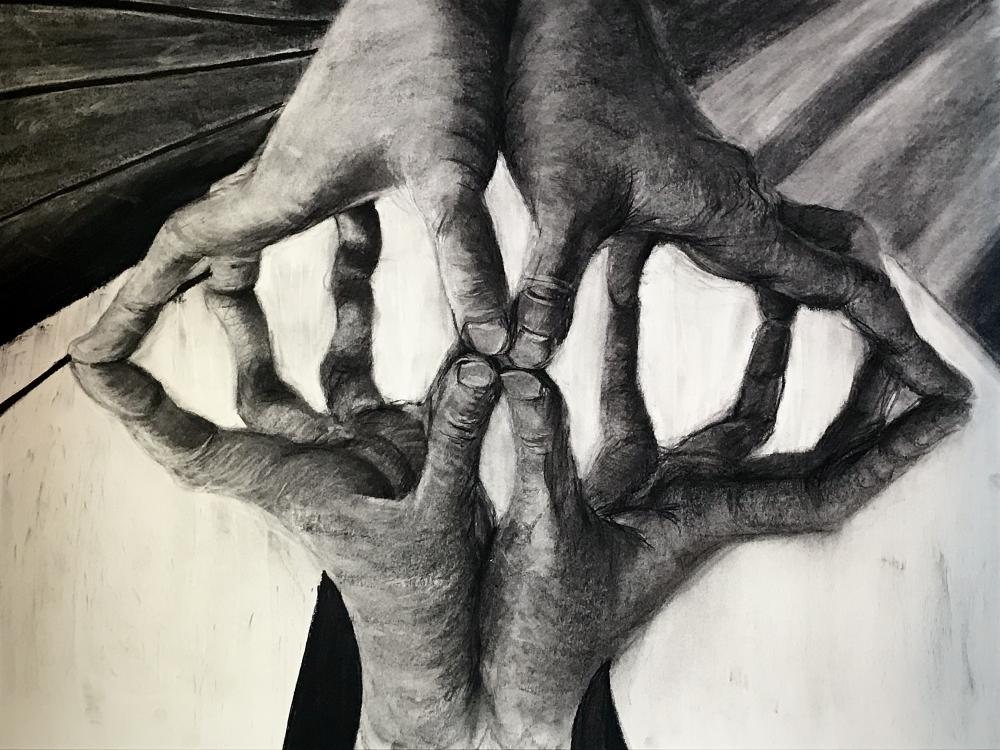Collection & Connection: Responsive Portraiture
Virtual exhibition created by students in "Art Studio 220: Drawing II: The Human Figure and Other Natural Forms” taught by Gina Siepel, Lecturer in Studio Art Foundations, Spring 2020
In collaboration with Ellen Alvord
Designed by Nina Frank
sunnywei_975x850.jpeg

Sunny Wei '23
INTRODUCTION
The drawings represented here come from my class, “Drawing II: The Human Figure and Other Natural Forms.” In this course, we use drawing to simultaneously explore the study of nature, and an understanding of the human body rooted in anatomy, embodied perception, and empathy. Students worked from live figure models in class while conducting independent projects in the study of non-human natural forms. Classwork is centered around communal engagement and haptic and materially-based exploration.
When the college was forced to close by the Coronavirus epidemic, we were faced with the loss of the ability to work in an embodied way together. Given the nature of our new circumstances, it made sense to shift the emphasis for the figurative portion of the course to portraiture.
In consultation with Museum staff, I created an assignment in which students would be invited to relate closely to an artwork from the museum’s collection, and to respond personally to it. Working together, we curated a diverse selection of figurative and portrait drawings, paintings, prints, sculptures, and photographs from the collection, spanning a wide range of historical eras and cultures. Students were asked to choose a single artwork from this selection, and to create two works that explored a personal response to that piece, one of which is shown here.
Students were guided by a variety of interests - some were drawn to formal and material aspects of the original artwork, while others explored particularities of the figure’s pose or mood. All of the works were drawn from direct observation in students’ home circumstances, using available materials, and engaged connections between their current realities and their chosen artworks. It’s been wonderful to see the resourcefulness and imagination with which students have responded, and to see the glimpses of people, places, and stories particular to their personal experiences of this unprecedented time.
Gina Siepel
Lecturer in Studio Art Foundations
Note: Artworks on the left are from the Mount Holyoke College Art Museum collection and drawings on the right are by students. Click on images to see enlarged versions.
Charlotte Anderson '21
Meg Bonilla '23
I was initially drawn to this Elizabeth Catlett’s serigraph Francisco because of its eerie nature. The man depicted seems to be focusing on someone or something with great intensity. The eyes and square-rimmed glasses are the focal point of the image. I wanted to respond to this focal point by drawing the person staring right back into the man’s eyes. My portrait, alarmed by his intense gaze, takes off his glasses in the drawing, preventing his stare. In responding to Catletts’s piece, I hoped to capture the delicate nature of the serigraph and its beautiful simplicity. Besides the hair, the man is painted in delicate shades of grey and I tried to recreate this monochrome airiness of lightest lights and mid-tones.
Lexxey Boron-Smith '20
In consideration of the work Seated Nude Woman by Minerva Josephine Chapman, I was interested in creating a similar scene, with a different tone. I noted the lightness and minimal mark making of the original piece, along with the cross-contour shading which gave life to the form of the model. In my drawing, I hoped to both pay tribute to the original work while creating contrast between the two. My work utilizes high contrast of light and dark, which emphasizes cross contour marks on the body and the folds of fabric. In reflection of the original piece, I made the choice not to include the model’s head. This choice was based on my belief that the obscurity of the figure’s face in the original piece, allows the focus of the piece to shift away from the eyes.
Verity Boyer '23
I selected the portrait La Femme en jaune by Albert Besnard. I was curious about the relationship between the figure and ground, particularly the way the composition and handling of texture create a sense of the woman within her context/environment. The medium (ink and wash) was also intriguing to me in how it emphasized line work as a central concern of the piece. Finally, I was interested in the handling of the subject matter, the kind of politics that surround women as subjects and objects within the male gaze and the implications of domesticity.
Ella Giordano '22
I was intrigued by Jacob Jordaens’s Study for the Cook in The King Drinks, because of the contorted facial expression. Unable to pinpoint the exact emotion being portrayed, I felt unresolved, which only made me engage with the image further. The drawing has a tactile quality, where I can feel the softness of the form and volume in folds and creases of the skin. In my piece, I explored the literal and figurative tension and irresolution created by a pinched expression. I considered the questions a viewer might be left with, and which questions I should answer in my image.
Sophia Hess '22
My Drawing Hermano Nopal is inspired by David Driskell’s Thelma Festival II, whose dark color and bold composition of human and natural forms pulled me in. Driskell’s work breaks traditional portrait hierarchies in which natural elements are considered decorative by decentering the face. In my work, I explored these hierarchies by depicting my brother’s face in equal proportion to the prickly pears he harvested in the mountains behind our house. Though our ancestors are indigenous to South America and not el Norte, I felt that my brother’s first harvest of native nopales was significant, and I strove to reflect the turmoil of the associated displacement, borders, and colonialism in my work.
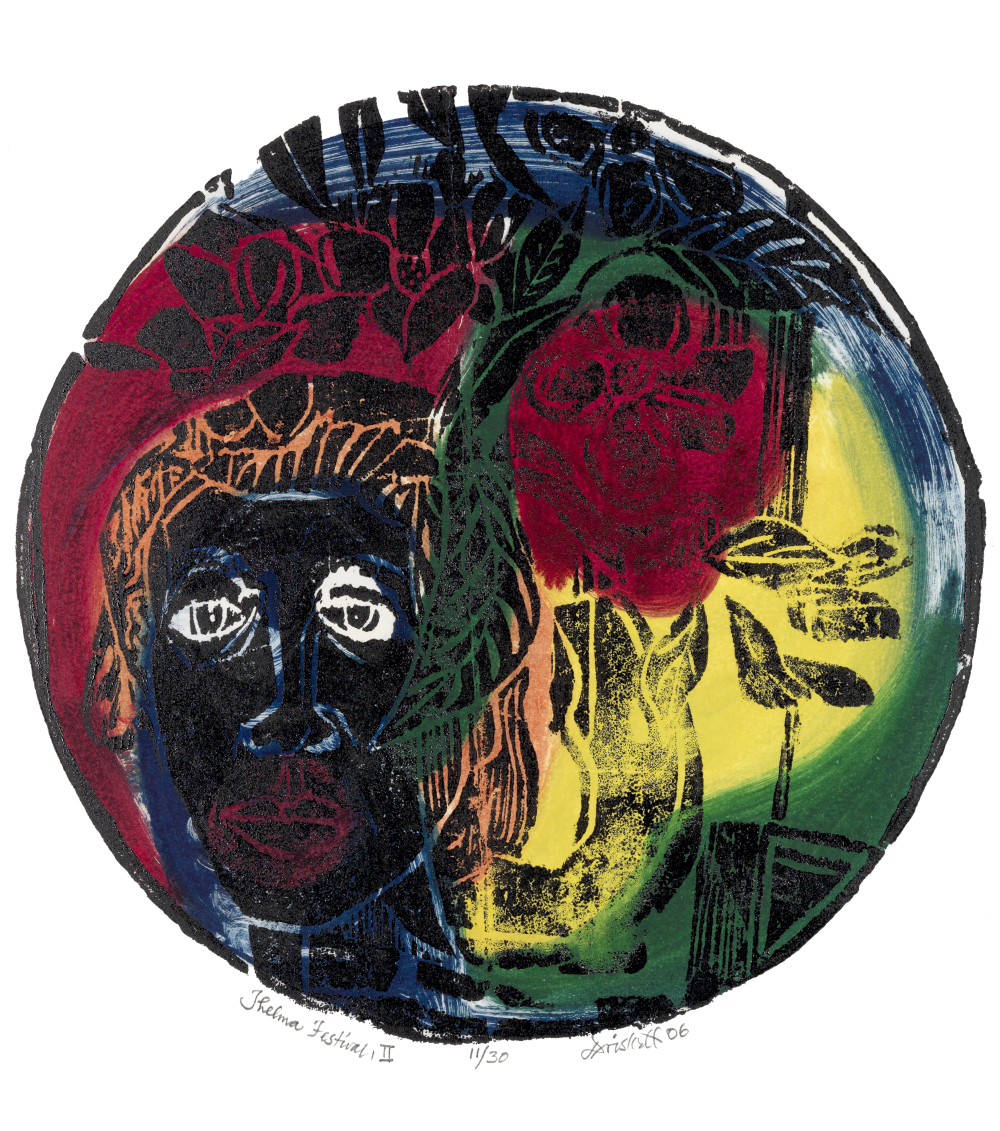

Fiona Hinds '21
I chose Immortal Koshohei turning rocks into Goats by Yanagawa Shigenobu I, because I was interested in the different fabrics and its interesting mythological imagery, as I am very interested in art that uses narratives to tell a story. The delicate style of Japanese prints sharply contrasts my usual drawing style, so I wanted to see how the two would combine. I wanted to create a sense of lightness in my portrait: both in the mood and the flowy nature of the fabrics. I also wanted to lean into the mythology and the slight sense of strangeness in the piece.
Cordelia Jones '21
Alfred Leslie's Self Portrait is striking because of its unconventional lighting and the contrast in detail between the figure and his clothing. While the face is very three-dimensional and the hair is incredibly detailed, the shirt looks much more flat. But even the less detailed areas of the self portrait show clear intention, which is a feeling amplified by the directness of his pose. I wanted to express the same attitude and level of purpose, so I mimicked his pose and clothing, used similar lighting, and explored the interaction of different levels of detail using that as a base.
Piper Kilgore '23
For my portrait, I chose to remake The Girl In White by Edwin Child. While the pose of my model is different from the original, I felt that the most important parts of the original painting were the facial expression, which I feel expresses a daydream or mental escapism, and the soft white fabrics that the model wears. Rather than having my model looking off into the distance at a party, she is alone and looking down into her book, providing her own escapism. She is also wearing a white dress and is surrounded by flowing fabric, recalling the peacefulness of The Girl In White.
Hannah Macdonald '20
Cat by Leonard Tsugouharu Foujita caught my eye with its unique mark making and strong sense of texture. His use of white lines on a dark background to make the cat pop, but he also strategically leaves out marks on the cat where it had dark patches of fur. With two white and black cats of my own, I wanted to replicate this style of leaving negative spaces where the fur was dark, as well as communicating fur through a variety of white marks. Initially I planned to create my response drawing with white pencil on black paper, in order to replicate Foujita’s effect, but unfortunately I did not have access to black paper, so I went with gray. I employed similar mark making techniques in a more structured way, and used solid lines when necessary to delineate features and distinguish the two cats from one another.

Fiona Rogers '22
I became interested in the dichotomy of timeless pose and very dated clothing in Albert Besnard’s La Femme en jaune. I attempted the same sort of positioning of my model with the intention to make a modern reflection of the original portrait as the two women face each other across time and space. Although I did not have the same resources, I tried to recreate the scratchy feeling of an etching. This drawing for me has been an exploration in mark-making with compressed charcoal, chamois, eraser, and graphite.
Eleanor Schanilec '20
For me, this was a very emotional last art assignment before graduation. When I first saw Felix Bracquemond’s La terrasse de la Villa Brancas, I was drawn in by the casual relaxation of a figure posing for a portrait by her sister, along with their decadent outfits and the outside view. Initially I wanted to draw my sister in her favorite clothes, but as we’re quarantined away from each other I instead drew on the idea of drawing a dressed up loved one lounging at the park in a-historical costume. One is graphite, the other is ink and colored pencil on paper.
Zofia Topor '22
I love examining hands—they can tell so much about a person, much more than someone’s age. Calluses and manicures speak of two different lives, both wonderful and captivating, but inherently different. I was captivated by Rena Small’s portrait of Jean Michel Basquiat’s hands. The effortless pose tells so much about his soul in conversation. I wished to recreate that within my own work. This charcoal drawing was done on 11 x 14” paper. In my drawing I aimed to represent hand positions that have been used as Christian iconography.

Abby Tuckett '20
It was the dark shadows near the eyes that initially drew me to Alfred Leslie’s Self Portrait. The drama and dynamic changes created across the face emphasizes the change in surface, an element I want to focus on. Furthermore, the markmaking changes across the materials. Each material has a distinct way of being represented, distinguishing the item-specific methods to utilize the same tool. When approaching my own drawing, I built up the surface using various marks, emphasizing the shadows created by a lamp placed at my feet, following the choice of Alfred Leslie. Using a combination of graphite and ink, I built up the shadows, drawing focus to the shapes and surfaces on my own face.
Ohana Turbak '20
I was drawn to Charles de Toulouse-Lautrec reading 'Le Figaro' by Henri de Toulouse-Lautrec because of the way it depicted a very mundane activity—someone reading a book with their feet up on a chair. It seems unstaged, almost like a candid photo. The drawing is visually interesting because of the strongly foreshortened pose and the way the lines and minimal shading describe the form and folds of clothing. I wanted to do a portrait that depicted a family member doing a similarly mundane activity, and was interested in the fact that most of the time, our mundane activities involve using a phone or computer, so I drew my mom using her computer and phone, and used a similarly foreshortened pose.
Sunny Wei '23
I am drawn to Foster's Pond Millenium, 1/1/2000 by Arno Rafael Minkkinen. The photograph is so interesting. With the mist and fog in the background and the mirror-like water in front of the viewer, hands and feet are intertwined together and create an illusion of a bizarre creature with their reflection. The atmosphere is so peaceful and tranquil. The figure in the reflection reminds me of Mirror Piece I & II: Reconfigured (1969/2018-2019) by Joan Jonas, that I watched on the Art Museum website. The reflection of human body parts and the bizarre image encourage me to think and reflect on myself. I encourage viewers to tilt their heads and look at my first artwork from different angles; it would be a fun experience.

 Give
Give
